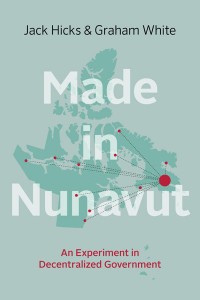When Nunavut became a territory they put the Motor Vehicle Division in a village called Gjoa Haven. Nobody can drive there; Gjoa Haven is on an island. All of Nunavut has no highways and only 5,000 registered vehicles anyway.
Nunavut’s creation was not merely the world’s largest Indigenous land claim but an experiment in community-based government. “There was a sense at the Nunavut Implementation Commission that we were creating a big, new beautiful world,” one official tells the authors of Made in Nunavut.
Did it work? “More than one person interviewed used the word ‘mindless’ to describe some of the moves made to accommodate job targets,” authors write.
Made in Nunavut is meticulous and beautifully researched. It recounts an experiment in governance in the strangest place on earth, a territory of 1.9 million square kilometres flung across three time zones inhabited by a string of hamlets where “even basic phone service was often problematic,” authors write.
The territory has fabulous reserves of oil and gas, diamonds and minerals in a land so unforgiving its main revenue source remains a $1.6 billion annual grant from the Government of Canada. If Nunavut is very lucky it will someday have the population of Red Deer. As one former Indian Affairs minister put it, “Why are we doing this for 25,000 people?”
“Here was a small, marginalized Indigenous people who had succeeded against long odds and through entirely peaceful means in establishing a government they controlled within the Canadian state in order to gain control over their lives, their land, and their resources – and ultimately their destiny,” write authors Jack Hicks and Graham White.
Hicks is a former research director for the Nunavut Implementation Commission. White is professor emeritus at the University of Toronto’s political science faculty. Made in Nunavut is the definitive analysis of the nation’s most ambitious trial in home rule.
“Decentralization in Nunavut was to be fundamentally different,” authors note. “Not only were a substantial number of government jobs to be located in small communities throughout the territory, but many of the government functions to be spread across the territory were ‘headquarters’ activities that, in most governments, are located in the capital.”
So, they put the Motor Vehicle office with a director and two clerks in Gjoa Haven. Eight other employees are assigned to Iqaluit, Rankin Inlet and Cambridge Bay. When the Wildlife Management Division was moved to Igloolik, only 11 of 22 positions were filled. An attempt to relocate the Workers’ Compensation Board to Pangnirtung saw managers complain they’d “risk losing highly-trained, dedicated staff.”
Nunavut as a new territory had few Inuit lawyers, accountants and engineers, and saw crippling attrition in hiring outsiders. In the first year 31 percent of employees quit. “Some adventurous Southerners were attracted by the prospect of being involved in an exciting new venture in governance, though many had more enthusiasm than experience in any government context let alone in northern Canada,” authors note.
Turnover still runs at about 20 percent a year, a serious problem in any organization. As one Nunavut manager explains, “We have a whole bunch of empty positions because no one wants to come here.”
By Holly Doan
Made in Nunavut: An Experiment in Decentralized Government, by Jack Hicks & Graham White; University of British Columbia Press; 392 pages; ISBN 9780-7748-31048; $34.95






